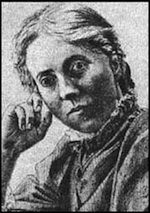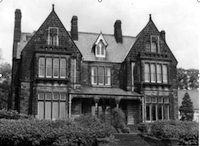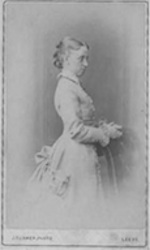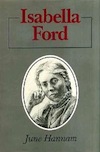JUNE HANNAM traces the life of Isabella Ford, the Leeds ILPer whose tireless campaigning for women’s rights, ‘new life’ socialism and peace remains an inspiration today.
Isabella Ford was one of a small number of middle-class women who joined the Independent Labour Party in the 1890s; for her, the struggle for socialism was inextricably bound up with the two other causes that she campaigned for throughout her life, women’s rights and peace. Her upbringing in a Quaker household steeped in radical liberal politics, women’s rights campaigns and humanitarian causes created a context for the development of her later ideas.
The youngest of eight children she was born on 23 May 1855 in Headingley, Leeds. Her father, Robert Lawson Ford, was a solicitor and landowner while her mother, Hannah, was a member of the Pease family of Darlington. When Isabella was 10 the family moved to Adel Grange, a large house on the outskirts of Leeds, which was to remain home for Isabella and her two unmarried sisters, Bessie and Emily, until after the First World War.
Their parents took an interest in political and social questions. They were involved in the anti-slavery campaign, financed a night school for mill girls and welcomed leading political figures such as John Bright MP and the Italian leader Mazzini into their home.
Hannah Ford also took a keen interest in the movement for women’s rights. Katherine Bruce Glasier, who became a close friend of the Ford sisters, later claimed that “Finding her old fashioned father implacably opposed to his daughters’ desire for higher education and for service in the movement for women’s enfranchisement, Mrs Ford had quietly ‘nourished active rebellion’”. (Bradford Pioneer, July 1924) Isabella also described her mother as “quite a revolutionist” and recalled that she taught her daughters to “never laugh at what is new”. (Leeds Weekly Citizen, 12 June 1914; Mallon 1908, p.251)
It is hardly surprising therefore that the Ford sisters were open to new ideas. They read a wide range of texts that were critical of laissez faire capitalism and in a reaction against materialism sought to explore the inner self and to find different ways to relate to other people. These new ways of thinking were given a firmer shape once they met Edward Carpenter who gave a series of lectures in Leeds in 1875. They became lifelong friends and it is almost certainly Carpenter who introduced them to the writings of Walt Whitman who was seen by many as the “prophet of a new democracy”.
The sisters also spent time in a small flat in London where Emily was a student at the Slade School of Art. Here they relished the freedom to mix with like-minded men and women, to discuss radical politics and to explore the possibilities that could open up for women if they remained unmarried, all of which can be glimpsed in a novel, On the Threshold, written by Isabella in the early 1890s. They also spent time with their cousin Edward Pease and were present at the first of a series of meetings in his flat in 1883 which led to the establishment of the Fabian Society.
Working women
At the same time Isabella was becoming more involved in attempts to improve the wages and employment conditions of working women. In 1885 Emma Paterson, a friend of her mother, encouraged Isabella to help establish a Tailoresses’ Society in Leeds under the auspices of the Women’s Protective and Provident League. When this collapsed the following year she established a Workwomen’s Society which was open to all women workers. Very few women joined the society but Isabella’s activities brought her into contact with members of the trades council.
These links with the labour movement were then reinforced during the labour unrest which was widespread in the city between 1888 and 1890. Isabella helped in strikes among women weavers where she met Ben Turner, a leader of the Textile Workers’ Union, who was to remain a lifelong friend. She took a leading role in the lengthy Tailoresses’ strike of 1889, giving rousing speeches at public meetings, organising the collection and distribution of relief, and publicising the strikers’ cause in the press. The following year she helped in the Manningham Mills dispute in Bradford where she walked through the sleet and snow with the women on strike “like a new Joan of Arc”. (Yorkshire Factory Times, 20 Feb 1891)
Isabella’s attempts to organise women workers gave her real insights into their lives. During the Manningham Mills dispute, one of the strikers, who had an invalid sister and a father who drank, stole a collection box. Isabella reacted by saying, “I have never felt absolute hunger … but these girls did… I was only sorry there was no more in the box. She had awakened to the right to possess something.” (Leeds Weekly Citizen, 12 June 1914)
Isabella was scathing of middle-class philanthropists who sought to ‘rescue’ women workers rather than to deal with the causes of their subordinate position at the workplace, and believed that women workers must act independently to change their own conditions. It was the task of people like herself, and of trade unionism, to awaken the desire for change and to “fight against every form of conventional thought … particularly among the women themselves”. (Women’s Trade Union Review, January 1900)
When she first began to organise women workers Isabella was still involved in liberal politics, helping to form a Leeds branch of the Women’s Liberal Association in 1885. During the labour unrest, however, she worked closely with members of the Socialist League, including Tom Maguire, and claimed later that she found that, although the Liberal Party was the “avowed advocate of trade unionism … the Liberal employers were quite as bitter against any of their female employees who dared to join a union”. (Labour Leader, 1 May 1913)
She disliked the tone in which they spoke to the tailoresses which showed that contempt on the part of men towards women underpinned the social structure. Speaking at the opening of the West Ward Labour Club in January 1893, she “rejoiced to see women sitting there on equal terms of equality with men as members”. When a Leeds branch of the Independent Labour Party was established in 1893 Isabella and her sister Bessie were among the first to join because the ILP stood for “equality and opportunity for the whole race … women had never had such equality before”. (Yorkshire Factory Times 20 Jan 1893; Ford, Why women should be socialists, p.10).
During the 1890s Isabella carried out propaganda work for the ILP throughout the West Riding of Yorkshire, speaking “often at street corners, in dingy club rooms, in hot, crowded school rooms”. (Glasier, Bradford Pioneer, July 1924) She was one of the ‘new life’ socialists who gathered around Edward Carpenter, while Adel Grange (left), where Isabella lived with Bessie, became a centre for all those interested in socialism and women’s rights, and attracted visitors from all social classes.
She never saw socialism as meaning simply a change in economic and social structures, but argued instead that it would bring beauty and justice into the lives of working men and women, and would provide the potential for full human development. Thus when she opened a Women’s Trade Union Club in Leeds in 1897 she took great care in choosing a bright coloured paint and wallpaper, decorated with daffodils and sweet peas, since “beauty of all sorts is excluded from so many of our girls’ lives, that it shall not be excluded from their club”. (Women’s Trade Union Review, January 1897)
Socialism and feminism
After 1900, despairing of her lack of success in organising women workers, Isabella devoted more time to socialist and feminist politics as the best way to improve women’s lives. She was elected to the National Administrative Council of the ILP between 1903 and 1907 and embarked on a punishing schedule of meetings that took her all over the country. She also found time to write a pamphlet, Women and Socialism (1906), in which she expressed her views about how women’s emancipation and socialism were inextricably linked.
It was also at this time that the campaign for women’s suffrage was gaining a new momentum. Isabella was a strong supporter of the demand for women to have the vote on the same terms as men. The ILP as a party was also committed to support for a limited franchise, although some members of the NAC appeared to be lukewarm on the issue. Isabella, therefore, decided to join other committed suffragists in giving priority to the suffrage campaign.
She was elected in 1907 to the national executive committee of the National Union of Women’s Suffrage Societies, led by her close friend Millicent Fawcett, and, with the exception of 1911 when she was ill with diphtheria, continued to serve in that capacity until 1915. Yet again she put her talents as a speaker to good use at meetings throughout the country. One contemporary noted that “she speaks with equal success to an audience of 5,000 working men or 25 clergymen – they laugh and weep as she chooses, and they all love her”. (Common Cause, 3 October, 1913). She took part in deputations to the government and also attended international congresses in several European countries.
Isabella continued to believe that the labour movement and the women’s movement should move forward together and played a part in negotiations to form a pact between the NUWSS and the Labour Party. She was overjoyed when the Election Fighting Fund was formed to support labour candidates at bye-elections: “I feel comradeship, the real thing, is growing fast just because of this battle. I never felt anything like it sometimes and it’s growing amongst our sort of women… I feel like bursting with joy over it at times.” (Letter from Isabella Ford to Edward Carpenter, 25 August 1913)
Throughout her life Isabella Ford enjoyed the support of a wide circle of friends from different class backgrounds who were active in the causes that she held dear. There were times when her varied interests could lead to conflict with friends such as Millicent Fawcett, who took a different stand on the First World War, but in the long term the friendships survived. This was largely because of Isabella’s conciliatory personality. One contemporary described her as “broad and well-balanced, and even for suffrage … refuses to be a fanatic … she swims in the mainstream, she belongs to the centre … sweet humour puts a twinkle in her eye and on her lips a laugh, at herself maybe, with no bitterness”. (Mallon, 1908)
Her role on the executive committees of key organisations, and her talents as a speaker and a writer meant that after 1900 she became well known outside the West Riding of Yorkshire. She was the subject of short biographical sketches that appeared in the press, and was interviewed about her own views on what had led her to take up socialist and suffrage campaigning.
These short sketches provide a basis for understanding what motivated Isabella, but we need to exercise caution in how we read these versions of her life. For example, male friends in the labour movement tended to portray her in idealised terms, emphasising her gentleness and her “keen pity for all suffering creatures” at the expense of her undoubted political toughness. She had to withstand hostile crowds and faced difficult reactions from both middle-class contemporaries and from some working men because of her involvement in the labour cause.
She was also quite capable of making fighting speeches. At the annual conference of the NUWSS in 1914 she spoke against any co-operation with the government for war purposes “with a pugnacity of word and gesture which took everyone’s breath away, and then, having had her say, stamped off the platform and down the hall in almost ferocious style”. (New Leader, 25 July, 1924)
With the outbreak of war Isabella once again found herself working closely with friends and comrades from the ILP in the peace movement. She resigned from the executive committee of the NUWSS in 1915 and carried out peace propaganda on behalf of the Union of Democratic Control and the Women’s International League, both at a national level and in Leeds where she set up a branch of the WIL and of the Women’s Peace Crusade.
After the end of hostilities she continued to carry out propaganda for socialism, women’s rights and peace – for example, she attended an International Congress of Women in Zurich in 1919 and campaigned for her old friend Phillip Snowden at the 1923 General Election.
Nonetheless, age and ill health curtailed her public activities and she never recovered from the death of her sister Bessie in 1919 who had given her so much practical and emotional support. In 1922 she moved with her sister Emily to a small cottage, Adel Willows, and it was here that she died in her sleep on 14 July 1924.
—-
June Hannam is Professor Emeritus in Modern History at the University of West  England, Bristol, and author of Isabella Ford, 1855-1924, Oxford, Blackwell, 1989.
England, Bristol, and author of Isabella Ford, 1855-1924, Oxford, Blackwell, 1989.
Click here to watch June’s talk about Isabella Ford at the Peace History Conference in Manchester.
References in the text:
Isabella Ford, On the Threshold, Edward Arnold, 1895
Isabella Ford, ‘Why women should be socialists’, Labour Leader, 1 May 1913
Isabella Ford, Women and Socialism, 1906
JJ Mallon, ‘Isabella Ford’, Woman Worker, 7 August 1908


